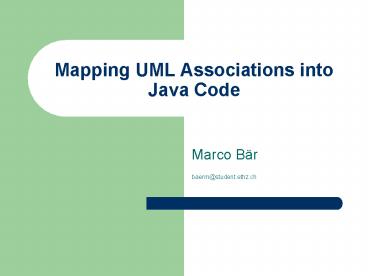Mapping UML Associations into Java Code - PowerPoint PPT Presentation
1 / 25
Title:
Mapping UML Associations into Java Code
Description:
Navigability. Visibility. 9/3/09. Marco B r. 5. Multiplicity ' ... 'Navigability specifies the ability of an instance of the source class to access ... – PowerPoint PPT presentation
Number of Views:123
Avg rating:3.0/5.0
Title: Mapping UML Associations into Java Code
1
Mapping UML Associations into Java Code
- Marco Bär
- baerm_at_student.ethz.ch
2
Overview
- Motivation
- Problems
- Multiplicity
- Navigability
- Visibility
- Interface
- Conclusion
3
Motivation
- Associations are key concepts of OO
- No language support
- Implementing Associations is repetive and error
prone - Constraints and Invariants left to programmer
- Code is difficult to maintain
4
Problems
- Multiplicity
- Navigability
- Visibility
5
Multiplicity
1..
0..1
Person
Company
works for
- Specifies the number of target instances that
may be linked to a single object of the source
class - denotes many
- Any subset of nonnegative integers allowed
- Paper deals only with intervals (min..max)
- Multiplicity Constraints are Invariants
6
Minimum Multiplicity
- Most common minimum multiplicities
- 0 optional
- 1 mandatory
- Remember the previous example
- Person ? Company is optional
- Company ? Person is mandatory
- What happens if a Company is created?
- It needs to be linked immediately to a Person!
7
Possibilities of creating a Company instance
- By an instance of Person
Person p new Person(personData) Company c
p.createCompany(companyData)
- With an instance of Person as parameter
Person p new Person(personData) Company c new
Company(companyData, p)
- Creation of a Company instance issues the
creation of a Person instance
Company c new Company(companyData, personData)
8
Changing Links Example
(a)
(b)
(c)
9
Consequence
- Mandatory associations pose unsolvable problems
- Solution
- Dont check the minimum constraints when
modifying links (e.g. mutator methods, or
setters) - Check the minimum constraints when accessing
links (e.g. accessor methods, or getters)
10
Maximum Multiplicity
- Most common maximum multiplicities
- 1 single
- Single associations can be stored in a simple
variable - multiple
- A Collection has to be used to store the
association references - Choices for Adder Methods
- Reject additions that violate constraints
- Perform additions that violate constraints (like
remove) - Single associations have to reject additions that
violate the multiplicity constraints
11
Example
0..
2..4
Game
Player
g1 Game
(a)
(b)
(c)
12
Summary of Multiplicity
- Adders
- Check maximum constraints
- Reject operations that violate maximum
constraints - Ignore objects already linked to the source
instance - Removers
- Dont check minimum constraints
- Ignore objects not linked to the source instance
- Getters
- Check both maximum and minimum constraints
- Raise exeptions if constraints are violated
- Users Responsibilities
- Use Remove and Add Methods in the right order
- Restore valid system state before accessing
associations
13
Problems
- Multiplicity
- Navigability
- Visibility
14
Navigability
Navigability specifies the ability of an
instance of the source class to access the
instances of the target class through the links
that connect them.
15
Unidirectional Associations
- Single
- A simple attribute is used to store the reference
- Multiple
- A Collection is used to store the references
16
Bidirectional Associations
- Cannot be implemented with a single attribute
- Three possible combinations of multiplicities
- Single Single
- Single Multiple
- Multiple - Multiple
17
Single - Single
18
Synchronization Example
19
Multiple - Multiple
20
Problems
- Multiplicity
- Navigability
- Visibility
21
Visibility
- UML Standart says
- specifies the visibility of the association end
from the viewpoint of the classifier on the other
end. - Possible visibilities
- public, protected, package, private
- package has different semantics in UML
22
What about Bidirectional Associations?
- No reciprocal update from Subject side!
- Private-private relations cannot be managed!
- Indirect access through public methods
- Similiar considerations for package and protected
23
Interface
- Accesor methods (get())
- min. or max. constraint violated ? exception
- Mutator methods
- add(Collection links), remove(Collection links)
- add(Type link), remove(Type link)
- none or all semantics
- maximum constr. violated ? cancel op return
false - type(link) type(target) ? cancel op exception
24
Conclusion
- Ups
- Reduces amount of coding
- Introduces automatic Invariant checks
- Additions/Modifications of associations possible
- Downs
- Add/Remove have to be invoked in the right order
- Valid system state has to be re-established after
modifiers were called
25
Thank you for your attention!
- Questions?































